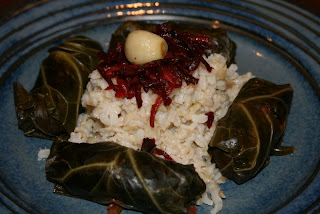One whiff of cornbread fresh out of the oven and I'm immediately transported back to my grandmother's kitchen in the hill country of northern Georgia. It's one of those powerful Proustian involuntary memories that grabs me in the gut and sends me back in time. The farm dogs bark outside, it's 81 degrees and cooling, flies linger around the screen door, my grandfather tells one of his famous policeman stories as I wipe the sweat from my brow, and the smells of fried okra, black-eyed peas, chicken strips, and cornbread permeate the kitchen. That's a bit of what cornbread conjures up for me...country roads, take me home, to the place, where I belong...
Adele cooks her cornbread in a cast-iron skillet as her aunts taught her, and that's exactly the way my grandmother used to do it as well. The cast-iron skillet makes cornbread into a nice round shape and is quite aesthetically-appealing, with the yellow bread constrasting the black skillet.
Cornbread is so easy that Adele doesn't have an official recipe for it. Rather, like her aunts and my grandmother, she just has it in her head (until now!).

This recipe fills an 8-inch skillet. Dry ingredients, to be mixed in a medium-sized bowl:
3/4 cup corn meal and 3/4 cup flour (preferably white whole wheat)
2 tsp baking powder
pinch of salt
(Sometimes I add some cumin, or dried cilantro)
Wet ingredients, to be mixed in a separate bowl:
1 egg, beat lightly with about a tsp or so of sugar
About 3/4 cup of milk (rice milk works fine)
A little under a 1/4 cup of oil
Heat the oven to 350. Put a good-sized pat of butter in the skillet and place it in the warming oven until the butter has just melted. Take the skillet out of the oven and turn it carefully so that the butter evenly covers the bottom and sides.
Pour the wet ingredients into the dry ones and mix with a wooden spoon just until all the liquid is absorbed into the dry ingredients. Pour into the skillet and bake until a knife comes out clean, about 30 minutes.
Serve with chili, like we did here. Also makes a nice and simple, healthy dessert, with butter and honey or molasses. I'm sure it would make great breakfast fare as well, but it usually never makes it that long in this house.
 We had ridiculously warm weather this weekend with highs reaching into the mid-80's, so after an afternoon of working under the hot sun in our garden and a small jaunt in our canoe out on Lake Cochichewick, we figured a barbecue was definitely in order. And a beer.
We had ridiculously warm weather this weekend with highs reaching into the mid-80's, so after an afternoon of working under the hot sun in our garden and a small jaunt in our canoe out on Lake Cochichewick, we figured a barbecue was definitely in order. And a beer. Top with a few slices of avocado...
Top with a few slices of avocado... and then with a generous serving of fresh salsa (see recipe below).
and then with a generous serving of fresh salsa (see recipe below).























